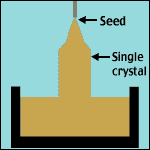Czochralski Crystal Growth Method
Created | Updated Aug 31, 2008

The Czochralski method is a technique for growing single-crystal silicon ingots for use in manufacturing semiconductor devices. The finished crystals are called boules. The boules are later sliced into very thin, circular wafers and then diced into the little silicon chips from which all silicon semiconductor LSI1 chips are made.
Growing large monocrystalline silicon boules is a tricky business. The Czochralski method (abbreviated as CZ in the technical literature) begins with silicon powder that is 99.999999999% pure2. A lot of that ridiculously pure silicon is placed in a large crucible that is made of fused quartz. The crucible is then put in a vacuum chamber, which is sealed and then filled with some conveniently inert gas, usually argon.
The chamber is then heated up to 1500° Centigrade or so, to melt the silicon. When the silicon is nicely melted, a small seed crystal mounted on the end of a rotating shaft is slowly lowered until it just dips below the surface of the red-hot silicon melt. The shaft rotates counterclockwise and the crucible rotates clockwise. Now, the rotating rod is drawn upwards very slowly, allowing a roughly cylindrical boule to form by some technical magic as it does so3. The boule can be from one to two metres or so long, depending on how much silicon there is in the crucible.
In the early days of the technology, the boules were quite thin, only a few inches wide. However, the crystal growers have had a lot of practice, and nowadays they can make nice, fat 300mm (12-inch) wide boules. The thickness is controlled by precise control of the temperature, the speeds of rotation and how fast the seed holder is withdrawn. Widths of 400mm (16 inches) are expected in the next several years. This is one reason for the rapidly decreasing cost of chips that we have enjoyed over the years, because more LSI chips can be created from a single wafer with the same number of fabrication process steps.
The electrical characteristics of the silicon are controlled by adding stuff like phosphorus or boron to the silicon before it is melted. The stuff added is called dopant and the process is called doping. This method is also used with semiconductor materials other than silicon, such as gallium arsenide.
As a necessary step in the production of large-scale integrated circuit chips, the Czochralski method is a basic technique in the making of computers, TVs, cell phones and the advanced electronic equipment of all kinds that shape modern life as we know it at the beginning of the 21st Century.

